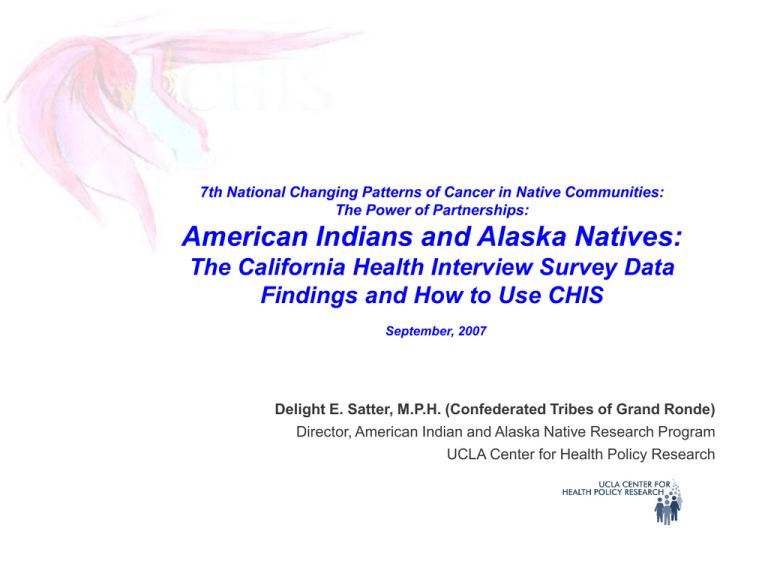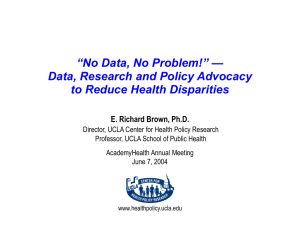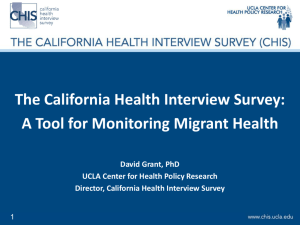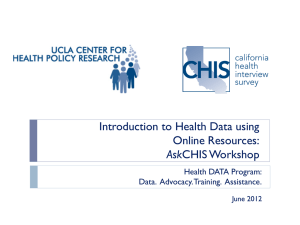CHIS presentation - Native American Programs
advertisement

7th National Changing Patterns of Cancer in Native Communities: The Power of Partnerships: American Indians and Alaska Natives: The California Health Interview Survey Data Findings and How to Use CHIS September, 2007 Delight E. Satter, M.P.H. (Confederated Tribes of Grand Ronde) Director, American Indian and Alaska Native Research Program UCLA Center for Health Policy Research Presentation Objectives Report cancer specific data findings from several studies conducted by AIANRP. Provide overview information on accessing the CHIS data, available to the public. Lastly, it will provide step-by-step instructions with examples on using AskCHIS, the CHIS on-line data query system. This section of the presentation will be interactive, live, and web-based. The audience will determine the data requests we run together. Examples of data queries the audience might request are: Estimating breast cancer screening rates for urban California Native women aged 40+ and pooling CHIS 2001, 2003 and 2005 data. Comparing cervical cancer screening rates for urban versus rural Native women across time. Estimating tobacco use rates for Native adults residing in Northern California versus Southern California. Comparing obesity rates for male versus female Natives by age groups (e.g. 1844, 45 – 64, 65+). Identifying differences in access to Indian Health Service by tribal affiliation. 2 American Indians and Alaska Natives in California Background More AIAN reside in CA than any other single state in the US. California is home to AIAN from 107 federally recognized tribes. AIAN residing in CA are extremely diverse with most being members from reservations outside the state as compared to those who are members from reservations inside the state. The majority of AIAN in CA live in urban areas, with Los Angeles being home to the largest urban population of AIAN in the country. 3 What is CHIS? A unique resource for California A public-private sponsored collaborative research project of: UCLA Center for Health Policy Research California Dept. of Health Services Public Health Institute Provides comprehensive information about the health of Californians Over time By geographic area (county) By population group/s Race/ethnic Poverty level Age Etc. 4 What is CHIS? A population-based telephone health survey Three separate interviews Adults (age 18+) Adolescents (age 12-17) Children (age 0 to 11) Widely disseminated Publications Public Use Files (PUFs) AskCHIS Internet query system 5 How is CHIS done? Conducted every other year since 2001 Statewide random digit dial telephone survey Sufficient adult interviews in each of 41 counties to provide statistically stable estimates Oversamples of Koreans & Vietnamese (and AIAN in 2001) One adult selected at random in each household; children and teens as appropriate Conducted in English, Spanish, Chinese (Cantonese and Mandarin), Korean, and Vietnamese Through a sub-contract with Westat, Inc. Nearly 2 million phone calls made in CHIS 2005 6 New for CHIS 2007 Cell phone only sample – to address this growing population Cell phone numbers are not included in RDD sample frames Method pilot tested in 2005 CHIS 2007: expand to a statewide sample of 800-1,000 and include in adult data files Area probability sample – to address declining response rates Area probability sample in Los Angeles County (sample of addresses rather than phone numbers) Telephone and in-person recruitment Compare estimates from RDD and area probability frames to explore non-response bias 7 CHIS sample design Change in geographic stratification Increased total number of strata from 41 to 44 Increased individual county strata from 33 to 41 New—Monterey, Humboldt, Nevada, Mendocino, Lake, Yuba, Sutter, San Benito Reduced multi-county strata from 8 (with 25 counties) to 3 (with 17 counties) Tehama-Glenn-Colusa Sierra balance (Tuolumne, Calaveras, Amador, Inyo, Mariposa, Mono, Alpine) New—Northern balance (Siskiyou, Del Norte, Lassen, Trinity, Modoc, Plumas, Sierra) 8 What information does CHIS collect? Rich demographic data, including: Age, sex, race/ethnicity, marital status Country of birth, years in US, citizenship, mother/father’s country of birth, language/s spoken at home, English proficiency Employment status, income, poverty level, educational attainment AIAN specific data: tribal affiliation(s), enrolled in state or federally recognized tribe, where enrolled Health behaviors, including: Alcohol and tobacco, illicit drugs (teens) use Physical activity, dietary intake, environmental Cancer screening, flu shot, HIV/STD testing, use of seat belts and bike helmets 9 What information does CHIS collect? Health conditions: General health Chronic conditions such as asthma, diabetes, heart disease, high blood pressure, COPD, etc. Disability Mental health Access to and use of health care services Usual source of care Visits to doctor, ER use Communication with doctor, need for translator, health literacy 10 What information does CHIS collect? Health insurance coverage: Current coverage Coverage type (employer-based, private purchase, MediCal, MediCare, Healthy Families) HMO enrollment and plan details Coverage past 12 months Employer Uninsured Reasons for lack of coverage MediCal and Healthy Families eligibility (age < 65) 11 What information does CHIS collect? Other topics & information Food security and hunger Public program participation … and numerous other topics Geocoding of households and schools Social relationships and neighborhood conditions (2003) Family history of cancer (2001, 2005) Inter-personal violence (2007) 12 How to Get CHIS Data How to get CHIS data? Public Use Files Source Files at the Data Access Center AskCHIS Internet query system Publications on the Center’s webpage www.healthpolicy.ucla.edu In journal articles 14 CHIS Public Use Files (PUFs) The CHIS Public Use Files are . . . Publicly available for free from the CHIS website Available separately for Adults, Children, and Adolescents Available for 2001, 2003, and 2005 Microdata files – each record in the file is an individual case (i.e., a completed interview) Available in SAS, STATA, and SPSS format 15 CHIS Public Use Files (PUFs) The CHIS Public Use Files . . . Include detailed demographic information, but do not include geographic identifiers or other sensitive variables that could disclose respondent identity Include imputed values for missing data for most variables Include sample weights 16 What are weights & How are they constructed? Weights are variables that can be applied to the data to produce population estimates There are separate weight variables for the adult, child, and adolescent files The weights are constructed through a complex and iterative process First, a base weight is calculated for each telephone number based on the probability of selection at the stratum level (county or group of small counties) and adjusted to produce a final household weight 17 What are weights & How are they constructed? The adult, child, and adolescent weights are produced in a similar fashion from the final household weight The adult weight is adjusted based on the number of adults in the household and then “raked” in an iterative process to control for several demographic and socio-economic characteristics The weights are raked to population totals at the county level based on California Department of Finance (DOF) population projections The weights for each CHIS file (Adult, Child, and Adolescent) sum to the total California population living in households as projected by DOF 18 An example of unweighted and weighted estimates Has a doctor ever told you that you had a cancer of any kind? Unweighted Weighted N Percent N Percent YES 4,272 11.2 2,127,075 8.3 NO 37,717 88.8 23,469,986 91.7 Total 42,044 100.0 25,597,061 100.0 Source: CHIS 2003 Adult Public Use File 19 How to use the weights? The weight variables are included in the Public Use Files The weight variable name is RAKEDW0 in the Adult, Child, and Adolescent files Weights are applied differently in different software packages Detailed instructions on how to apply the weights in SAS, SPSS, and STATA are available on the CHIS web site 20 What are replicate weights? In addition to the full sample weight (RAKEDW0), there are 80 additional “replicate weights” (RAKEDW1 through RAKEDW80) Replicate weights are used to account for the geographically stratified CHIS sample design The replicate weights allow accurate standard errors to be calculated (the estimates do not change), without revealing respondent geography The replicate weights are used with software packages such as SUDAAN and WesVar 21 CHIS confidential data Confidential CHIS data is available to researchers through the UCLA Center for Health Policy Research Data Access Center (DAC) – contact Brandan Troudt (btraudt@ucla.edu) DAC applications and additional DAC information are available online at www.chis.ucla.edu Confidential data can be accessed in person at the DAC or remotely through emailed programming code and results by contracting with the Center’s Statistical Support and Programming team (submit programming, or hire programmer) 22 Technical Assistance Additional documentation on CHIS survey methods, use of weights, data dictionaries, and the questionnaires are available on the CHIS web site at www.chis.ucla.edu Technical assistance on the Public Use Files is available at: Email: chis@ucla.edu Telephone: 866-275-2447 - Brandon Traudt Technical assistance on developing research question specific to Native studies: Delight Satter – delight@ucla.edu 23 CHIS total sample sizes 2001 2003 2005 Adult (18+) 56,270 42,044 43,020 Child (0-11) 12,802 8,526 11,358 Teen (12-17) 5,733 4,010 4,029 24 Source: A Pleasant, but Puzzling Surprise: Twice as Many AIAN Are Found in a Large Health Survey in California, AHSR, 2002, Yen and Satter Table 2. Expected and Actual Sample Yields by Race, CHIS 2001 African White American AIAN Unadjusted Census Percent 67.6% 6.9% 0.9% Expected Yield 70.4% 5.9% 1.1% Actual Yield 69.9% 4.7% 1.7% Asian 9.6% 8.1% 7.1% Other Race 15.0% 14.5% 16.6% Source: 2001 California Health Interview Survey 5 25 Racial/Ethnic data collection and reporting Race by Ethnicity American Indian, Alaska Native Native Hawaiian, Pacific Islander Asian, Asian African American American White Latino Non-Latino 26 Adult sample size by race/ethnicity - Single Race definition only 2001 2003 2005 9,460 7,135 6,369 Native Hawaiian Pac Islndr 219 152 120 Am Indian Alaska Natives 781 580 554 Asian 4,798 3,875 3,941 African American 2,764 2,691 1,954 White 36,729 26,506 28,979 Latino 27 Data collection results Graph 1. CHIS AIAN Sample Yields by Questions Percent of All RDD Known Race (52,451) 3000 2694 2138 2000 1000 0 332 311 Any mention of AIAN Named tribal heritage Enrolled Member Named the Enrolled Tribe N 2694 2138 332 311 Percent 5.1% 4.1% 0.6% 0.6% Includes persons interviewed in RDD survey and some county oversamples; it does not include listed oversamples. These sample sizes are preliminary and may change depending upon further data cleaning and processing. 28 Adult, teen & child sample size by - American Indian or Alaska Native one or more races definition 2003 2005 Adult 1897 1845 Teen 313 365 Child 463 370 29 Cancer Data published by AIANRP www.healthpolicy.ucla.edu Click on American Indian Research Program Click on Publications 30 How to use AskCHIS 31 How to get CHIS data and information on the health of Natives from www.healthpolicy.ucla.edu Run your own customized search using AskCHIS - Instantly get state and local data on hundreds of health topics Review publications and data reports Learn about current research Find out upcoming training workshop on AskCHIS 32 Great Data –what about my community outside California? Use indirect estimates approach: Rates x Population size in your community (by different age groups) = estimated # with disease/illness in your community. (Call a researcher or your local county epidemiologist for help – that’s why we’re here. Download worksheet from Center’s HealthDATA training materials online.) 33 34 35 36 37 Who are those people who report more 2+ races? 38 39 Felt Downhearted, sad, blue (from SF12) by gender, AIAN 40 Did see a health professional for mental/emotional problems by Access to IHS 41 Binge Drinking past month, AIAN, CA Source: 2005 California Health Interview Survey, Race - Census 2000 * = statistically unstable Adol. (12-17) Adult (18-64) Senior (65+) All Ages % 95% C.I. % 95% C.I. % 95% C.I. % 95% C.I. 7.2* (1.4 - 13.0) 24.9 (20.1 - 29.8) 6.4* (0 - 13.1) 19.9 (16.0 - 23.7) Binge drinking 42 Binge drinking, past month, AIAN, CA 43 Tested for HIV by Sexual Orientation, AIAN, 2005 44 Current Smoking status by Gender, 21 years old +, Any mention AIAN 45 Disability status by Gender, AIAN any-mention, CA 46 Physical Activity by CA Region, AIAN adults 47 Heart Disease (CVD) by Diabetes, AIAN adults 48 Live Interactive Session 49 For the Health of All Generations UCLA Center for Health Policy Research 50 Contact Information Delight Satter, M.P.H. Director, American Indian and Alaska Native Research Program UCLA Center for Health Policy Research delight@ucla.edu 310 794 2686




